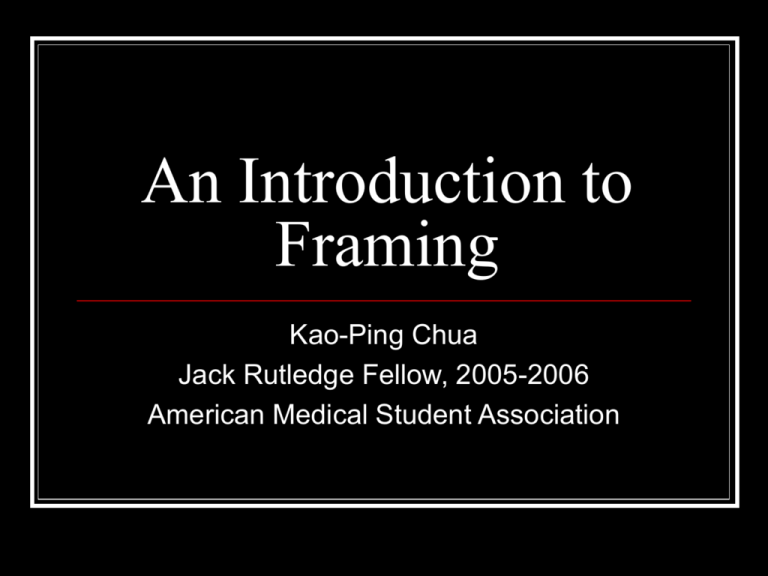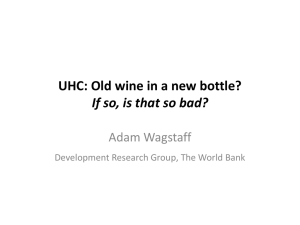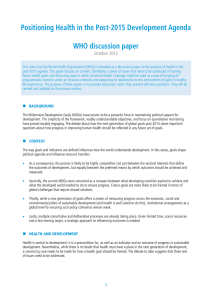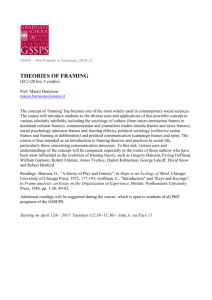Introduction to Framing - American Medical Student Association
advertisement

An Introduction to Framing Kao-Ping Chua Jack Rutledge Fellow, 2005-2006 American Medical Student Association Outline Framing 101 What is a frame? Why are frames important to politics? Example of framing: universal health care (UHC) How not to talk about UHC How to talk about UHC What is a frame? A frame is a conceptual structure used in thinking. Psychology equivalent: You can think of it as a “schema” Neuroscience equivalent: You can think of it a neural circuit (connected group of neurons and synapses) The “elephant” frame Big Elephant Animal Grey Floppy ears A frame is a story. The “elephant” frame tells the story of a big, grey animal with floppy ears. Frames can be changed (reframed) If a new species of pink elephants evolved and grey ones went extinct… Big Elephant Animal Pink Floppy ears Frames can be changed (reframed) Or, if the phrase “pink elephants” became wildly popular … Big Elephant Pink Animal Grey Floppy ears Framing and politics: “tax relief” Taxes have never been popular, but they were not always seen as an affliction as they are today. Tax opponents used the phrase “tax relief” to reframe taxes as an affliction. How “tax relief” reframes taxes Relief implies burden or affliction Person who relieves burden hero. The “hero frame” is activated people want to support hero. Person who supports burden villain. The “villain” frame is activated people want to oppose villain. Other “reframing” of taxes over past few decades Taxes are anti-American; they decrease the number of jobs and hurt the economy. Taxes are just a way for the government to take your money and waste it on inefficient social programs. “Tax” frame: before and after Duty Taxes Investment In America Enables government to function Affliction Taxes AntiAmerican Government waste Facts vs. Frame A person’s frame determines what truths a person is likely to accept George Lakoff: “If the truth doesn’t fit the existing frame, the frame will stay in place and the truth will dissipate.” The truth does NOT set you free -- the truth matters most if it fits the frame. Messaging vs. reframing Messaging is simply about coming up with a clever phrase – it’s advertising/marketing. Reframing is deeper – it is about changing our relationship to the world and how we think about it. How to use framing to generate support for an issue It’s not about finding a clever message… …but rather making sure that the message you use associates positive values with the frame of your issue. Lakoff’s levels of analysis Level 1: Universal values, like equity, justice, fairness, prosperity, etc. Level 2: Issue types: environmental issues, human rights issues, moral issues, etc. Level 3: Specific issues: housing, education, health care, etc. Level 1: Values and Principles Conservative Liberal/Progressive Self-discipline, Reward for work, selfdetermination, rugged individualism, personal responsibility, government hurts Obligation to the collective good, shared responsibility, unequal starting places need remedies, government helps Level 2: Issue Categories Moral behavior, taxes, education Poverty, social welfare, inequality Level 3: Programs and Policies Tax cuts, business incentives to create opportunity, short term “boot strap” help for individuals, medical savings accounts Child care, universal access to health care, housing, educational assistance so people can take advantage of opportunity Basic Argument Welfare hurts rather than helps by undermining the very attributes that people need to be successful (hard work, self-discipline etc). It makes people dependent rather than independent. It rewards immoral behavior by giving people something that they have not earned, thus worsening the problem. Welfare helps by giving people the basic necessities they need to be successful. It makes people independent by providing a helping hand. It encourages moral behavior of the society by sharing with those who are disadvantaged. It is a manifestation of our obligation to the collective good. Framing universal health care: an illustration of how framing works People’s FRAME about health care flies in the face of facts all the time. Many people will believe anything they hear about waiting lists in Canada… …and doubt evidence about the superiority of Canada’s system on health outcomes Of course, this is also true of supporters of a Canada-style system! Frames that work against UHC The government can’t do anything right Free market is more efficient Individual responsibility (ownership society) Anti-freeloading/anti-welfare Just desserts American exceptionalism Tax affliction How NOT to talk about UHC, #1 “Cover the uninsured” “There are 45 million uninsured Americans, which is 1 out of every 7 people in this country. 18,000 people die per year because they lack insurance, and millions more suffer from poor health. This needless suffering by the uninsured is unacceptable in a country as rich as ours. It is time for us to join the rest of the industrialized world and cover the uninsured.” How “Cover the uninsured” affects the UHC frame Universal health care Only benefits uninsured Welfare Welfare queen Enables laziness A better approach: “Cover everyone” “Health care costs are skyrocketing out of control, placing all of us at risk for losing health insurance through no fault of our own. In today’s rapidly changing economy, job turnover is at an all-time high, which means that all of us are just one pink slip away from being uninsured and risking financial catastrophe. It is our shared responsibility to ensure that every American can have the security from health care costs that they need in order to take care of themselves and their family.” UHC frame with “Cover everyone” vs. “cover the uninsured” Universal Health care Everyone benefits I’m affected Family’s affected Self-interest Family values Universal health care Only benefits uninsured Welfare Welfare queen Enables laziness This is not just a matter of semantics! If you continually say “cover the uninsured” when you talk about UHC, you are going to help reframe it as a welfare issue, which is BAD Once something has been framed a certain way, it’s HARD to reframe it. How not to talk about UHC #2 “Country X’s system is better than ours” Opposing frame: American exceptionalism Better approach: “We live in the wealthiest country on earth. Almost every major developed country provides health insurance for all of its people. No one in an advanced country like ours should have to worry about whether they can afford health care for themselves and for their families.” How not to talk about UHC, #3 Oodles and oodles of statistics Statistics, while important, are much less powerful at activating frames than direct appeals to values Stats don’t “speak to people” How to talk about UHC #1 The concepts “A rapidly changing economy means anyone can lose insurance” and “what if you didn’t have health insurance” are related to the frame “security”… So we must argue that universal health care will provide security! How to talk about UHC #2 The concept “Illness can wipe families out” is related to the frame of “family values.” …so talking about UHC as a way to help people take care of their families makes UHC a family value! How to talk about UHC #3 The concepts “It’s cheaper in the long run to make sure people can access care” and “preventive care for everyone means less disease” are related to the frame of “efficiency”… …so we should talk about universal health care as being economically efficient. Take-home points on framing Think about why your frame about an issue is the way it is – what values underlie it? Do the same thing for other people you’re trying to convince In the short-term, look for opportunities to turn their values into support for your issue In the long-term, be careful about how you frame your issue – always ask yourself, “What frames am I activating with the way I’m talking about my issue?” Summary and caveats In the end, framing is a powerful tool for achieving social change… But it’s just a tool… …and it’s not the only tool… …and the task is never just framing a single issue – other things (e.g. government) have to reframed as well.









